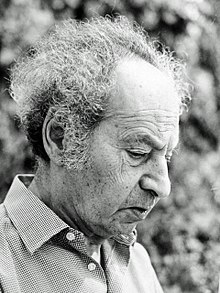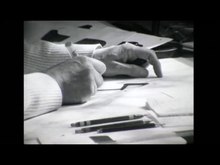Henri Friedlaender
Henri Friedlaender (born March 15, 1904 in Lyon , † November 15, 1996 in Jerusalem ) was a book designer and typographer .
Life
Henri Friedlaender's mother was English, his father German. When he was six, the family moved to Berlin, where he attended Mommsen-Gymnasium . He then began a two-year apprenticeship in graphic arts with Willi Simon and then worked as an office worker at Deutsche Chalcographie . In addition, he learned to write handwriting on his own in the library of the Kunstgewerbemuseum. In autumn 1925 he moved to Leipzig, where he attended the academy and also passed the master's examination ( handset ). In the following years he worked as a hand setter at Teubner and Wirth in Dresden, as a works setter at Jakob Hegner in Hellerau (where he learned a lot from Max Malte Mueller) and for the Klingspor in-house print shop under Max Dorn. During this time he worked with and for Rudolf Koch . He then became a typographic designer at Hartung in Hamburg and then a commercial factor and scheduler at Haag-Drugulin in Leipzig under Ernst Kellner. His job was to look after the "demanding customers" and a. at Insel Verlag and the oriental department u. a. at Schocken Verlag.
Friedländer left Germany in 1932 with the beginning of Nazi rule and moved to Holland until 1950 . In Holland he became artistic director of the Mounton & Co. printing house in Haag, where he created typographical works and font designs with German influence, which he continued to teach at his place of work. He also printed a specialist book and journals to spread his expertise. During the occupation years between 1940 and 1945 Friedlaender had to interrupt this activity, but still secretly printed sheets and prints (including Pulvis Viarum , a small series). The choice of texts explains his attitude: It was not about pamphlets, but rather fragments of the Bible that he himself translated as well as a text by Martin Buber .
In 1950 he took over the management and establishment of the Hadassah Apprentice School of Printing in Jerusalem . In 1970 he left school, devoted his work again to book design and continued to teach at various schools (including the Bezalel Art Academy in Jerusalem).
Friedlaender's wife Maria was the daughter of the physician Christian Bruhn and sister of the publisher Max Bruhn .
Fonts (selection)
- Books and brochures: Typographisch ABC (1939, Dutch)
- About Letters and Numbers (1960, Hebrew)
- Forms of the Book (1962, Hebrew)
- Color theory for printers (Hebrew)
- Modern Hebrew lettering . In: A Quarterly Review of the Arts and Sciences in Israel . No. 4 (winter 1962)
- The making of my Hadassah Hebrew . Edition for the members of the Association of German Book Artists. Kurt Christians and Richard von Sichowsky, Hamburg 1967
Exhibitions and prizes
- Silver medals: Paris World Exhibition 1937
- Triennial in Milan 1954
- International book art exhibition in Leipzig 1959
- Book Prize (Duwaer-Prijs) of the City of Amsterdam 1950
- Gutenberg Prize 1971 ("setting the course for the internationality of the prize")
See also
swell
- M. Keim: The Gutenberg Prize: an international message from the media city of Mainz since 1968 . Gutenberg Society, Mainz 1998.
- GW Ovink: The attitude of the typographer: Laudation on the occasion of the awarding of the Gutenberg Prize 1971 by the city of Mainz on June 21, 1971 to Henri Friedlaender . Small print from the Gutenberg Society, Mainz 1973.
- Grafici in ballingschap: Henri Friedlaender and Paul Urban, Duitse grafisch vormgevers in het Nederlandse exil 1932-1950 / inl. van Kurt Löb. Universiteitsbibliotheek Amsterdam, 1997. (Catalogus van een tentoonstelling in de Universiteitsbibliotheek van Amsterdam, 21 maart t / m 16 mei 1997.)
- Kurt Löb: Exile characters. German book designer in the Netherlands 1931-1950 , dissertation, Universiteit van Amsterdam, 1994. Handelsuitgave: Gouda Quint, Arnheim 1995 ISBN 90-387-0267-1
- Joseph Blumenthal: Typographic Years: A Printer's Journey Through a Half Century 1925-1975 . Frederic C. Beil, New York 1982.
- Paul Standard: Henri Friedlaender: A Koch Pupil Who Brings His Master's Reflective Spirit to the Dutch Book Arts. Print: A Quarterly Journal of the Graphic Arts no. 2 (1947), pp. 15-27
- Robert Ranc: Henri Friedlaender . Arts et techniques graphiques no. 85 (1972), pp. 3-26
- Israel Soifer: Henri Friedlaender: New Approach to Type. Publishers Weekly , July 1, 1968, pp. 74-75
- Ada Wardi (ed.): New Types. Three Pioneers of Hebrew Graphic Design. (Exhibition catalog), Israel Museum, Jerusalem 2016, ISBN 978-965-278-457-5 .
- Henri Friedlaender: Book Designer. Ariel (Jerusalem) no. 33-34 (Special literary issue, 1973), pp. 131-140
- Hans A. Halbey (ed.): Henri Friedlaender, in Scriptura. Harenberg Edition, 1990 ISBN 3-88379-599-2
Web links
- Literature by and about Henri Friedlaender in the catalog of the German National Library
- The Game of Their Lives
- William C. Fontaine: The Hadassah Type at Dartmouth's Graphic Arts Workshop in Baker Library , in the Dartmouth College Library Bulletin
- An Annotated Bibliography of Hebrew Typesetting (2001)
- Schets van Henri Friedlaender uit 1950 voor de productie van de Hadassah (1958)
| personal data | |
|---|---|
| SURNAME | Friedlaender, Henri |
| BRIEF DESCRIPTION | Israeli typographer |
| DATE OF BIRTH | March 15, 1904 |
| PLACE OF BIRTH | Lyon |
| DATE OF DEATH | November 15, 1996 |
| Place of death | Jerusalem |



